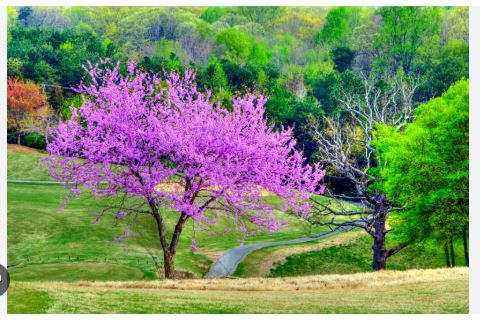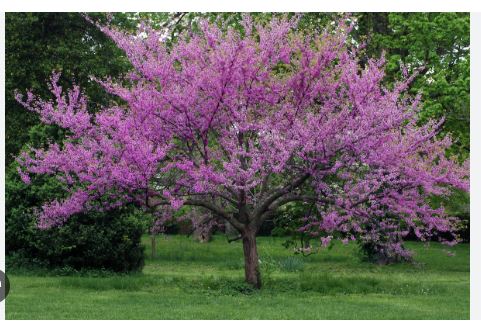
The Western Redbud, scientifically Cercis occidentalis, belongs to the Fabaceae family, a large group of legumes including peas, beans, and acacias. The genus Cercis, derived from the Greek word for “shuttle,” referring to the shape of its seed pods, contains about 10 species of deciduous trees and shrubs.
Cercis occidentalis is closely related to the Eastern Redbud (C. canadensis), but it’s distinctly adapted to arid western climates. As a member of the Caesalpinioideae subfamily, it exhibits nitrogen-fixing traits, enhancing soil fertility. Its taxonomic clarity distinguishes it from other redbuds, cementing its role in native plant horticulture.
Western Redbud is a multi-stemmed deciduous shrub or small tree, typically growing 6–20 feet (1.8–6 meters) tall and wide, with a rounded to spreading form. Its heart-shaped leaves, 2–4 inches (5–10 cm) long, emerge reddish-bronze, mature to glossy green, and turn yellow to red in fall.
In early spring, before leaves appear, vibrant magenta to pink pea-like flowers, 0.5 inch (1.3 cm), cluster along bare branches, attracting pollinators. These give way to flat, brown seed pods, 2–3 inches (5–7.5 cm) long, persisting into winter. The smooth, gray bark develops fissures with age, and young twigs are reddish. Its compact size and vivid seasonal changes make it a striking ornamental.
Cercis occidentalis is native to the western United States, primarily California, Arizona, Nevada, and southern Utah, with small populations in northern Mexico. It thrives in diverse habitats, including chaparral, oak woodlands, and canyon slopes, from sea level to 4,000 feet (1,200 meters). Preferring well-drained, rocky, or sandy soils, it’s often found on hillsides, along streams, or in mixed shrublands, tolerating drought and heat.
Beyond its native range, it’s cultivated in the Pacific Northwest, Southwest, and parts of Australia for landscaping. Not invasive, it spreads modestly via seeds dispersed by birds or gravity, remaining a keystone species in its native ecosystems.
Western Redbud is hardy in USDA zones 6a–9b, tolerating temperatures from -10°F to 100°F (-23°C to 38°C). It thrives in Mediterranean climates with dry summers and mild winters, ideal for California’s Central Valley or Arizona’s low deserts. In zones 6a–7a, it may suffer minor branch dieback during harsh winters but regrows vigorously. In hotter zones (8–9), it needs occasional deep watering to maintain vigor. Below zone 6a, it’s grown in containers with winter protection, requiring bright, cool indoor conditions (40–50°F/4–10°C) to survive frost-heavy climates.
Western Redbud is a versatile ornamental, prized for its vivid spring blooms, colorful foliage, and drought tolerance, making it a staple in native and xeriscape gardens. As a specimen plant, its compact form and magenta flowers create focal points in courtyards or mixed borders, while multi-stemmed shrubs form natural screens or hedges, growing 8–15 feet (2.4–4.5 meters) wide.
It’s ideal for erosion control on slopes, thanks to its deep roots, and enhances wildlife gardens by attracting bees, butterflies, and birds, which feed on nectar or seeds. In urban settings, it suits small yards, patios, or containers, offering low-maintenance beauty. Its wood is occasionally used for small crafts, and as a nitrogen-fixer, it improves soil health, supporting sustainable landscapes in arid regions.

Cultivation of Western Redbud (Cercis occidentalis)
Light Requirements
Provide full sun to partial shade, with at least 6 hours of direct sunlight daily to maximize flowering and foliage vibrancy. It thrives in open, sunny sites but tolerates dappled shade, especially in hotter climates. In shadier conditions, expect fewer blooms, so prioritize brighter locations for optimal performance.
Soil Preferences
Plant in well-draining, rocky, or sandy soil with a pH of 6.0–8.0, mimicking its native chaparral habitats. It tolerates poor soils, including clay, if drainage is adequate, but avoids soggy conditions. In containers, use a mix of 60% loam and 40% sand or perlite to ensure aeration and prevent root rot.
Watering Needs
Water deeply every 1–2 weeks during the first two years, providing 1–2 inches (2.5–5 cm) to establish roots, allowing soil to dry slightly between waterings. Once established, water monthly in summer, skipping winter unless unusually dry. Overwatering causes root issues, so check soil moisture to avoid excess.
Temperature Range
Grow in USDA zones 6a–9b, tolerating -10°F to 100°F (-23°C to 38°C). In zones 6a–7a, protect young plants from harsh freezes with mulch or burlap. In zones 8–9, it thrives with minimal care but benefits from occasional deep watering in heatwaves. In colder zones, grow in pots, overwintering indoors above 40°F (4°C).
Humidity Levels
Prefer low to moderate humidity (30–50%), suited to Mediterranean climates. High humidity may encourage fungal leaf spots, so ensure good air circulation, especially in humid regions. Avoid misting; dry air supports its drought-adapted foliage, and indoor plants need ventilation to prevent moisture buildup.
Container Selection
Choose deep pots with drainage holes, at least 18–24 inches (45–60 cm) wide, to accommodate its deep roots and shrubby growth. Heavy ceramic or resin pots provide stability for its rounded canopy. Repot every 3–4 years to refresh soil, ensuring space for its slow but steady expansion.
Fertilization
Apply a balanced, slow-release fertilizer (e.g., 10-10-10 NPK) once in early spring to support blooming and growth. As a nitrogen-fixer, it needs minimal feeding; excess fertilizer reduces flowers and weakens branches. In containers, use a diluted liquid fertilizer annually, avoiding applications in fall–winter.
Pruning
Prune in late winter or after flowering to shape, remove dead or crossing branches, or encourage bushiness, using clean shears to cut above a bud. Avoid heavy pruning, as it disrupts its natural form. Thin suckers to maintain a tree shape or remove lower branches for clearance, enhancing its multi-stemmed silhouette.
Propagation
Propagate via seeds or cuttings. Scarify seeds, soak for 24 hours, and sow at 70°F (21°C); germination takes 4–8 weeks. Softwood cuttings, taken in summer with rooting hormone, root in 6–8 weeks in a sandy mix. Seeds are slower, so cuttings are preferred for faster, true-to-type results.
Pest Control
Monitor for pests like aphids, scale, or caterpillars, which may target young leaves or stems. Inspect foliage, treating infestations with insecticidal soap or neem oil in early morning. Maintain healthy growth with proper watering and airflow to deter pests, as stressed plants are more vulnerable.
Repotting
Repot container-grown redbuds every 3–4 years in early spring, or when roots outgrow the pot. Gently remove, trim circling roots, and replant in fresh, well-draining mix at the same depth. Water lightly after repotting, keeping in partial shade for two weeks to minimize transplant shock.
Winter Care
In zones 6a–7a, mulch the base with 2–3 inches (5–7.5 cm) of bark or gravel to insulate roots; wrap young trees in burlap during freezes. In zones 8–9, trim dead twigs post-winter for tidiness. Indoor potted plants need bright light, cool conditions (40–50°F/4–10°C), and minimal watering.
Common Issues
Address overwatering (yellow leaves, root rot) by improving drainage and reducing frequency. Underwatering (leaf wilt, sparse blooms) requires slight watering increases. Poor flowering may indicate too much shade or excess nitrogen; adjust light or fertilizer. Fungal leaf spots are prevented with better airflow and avoiding overhead watering.